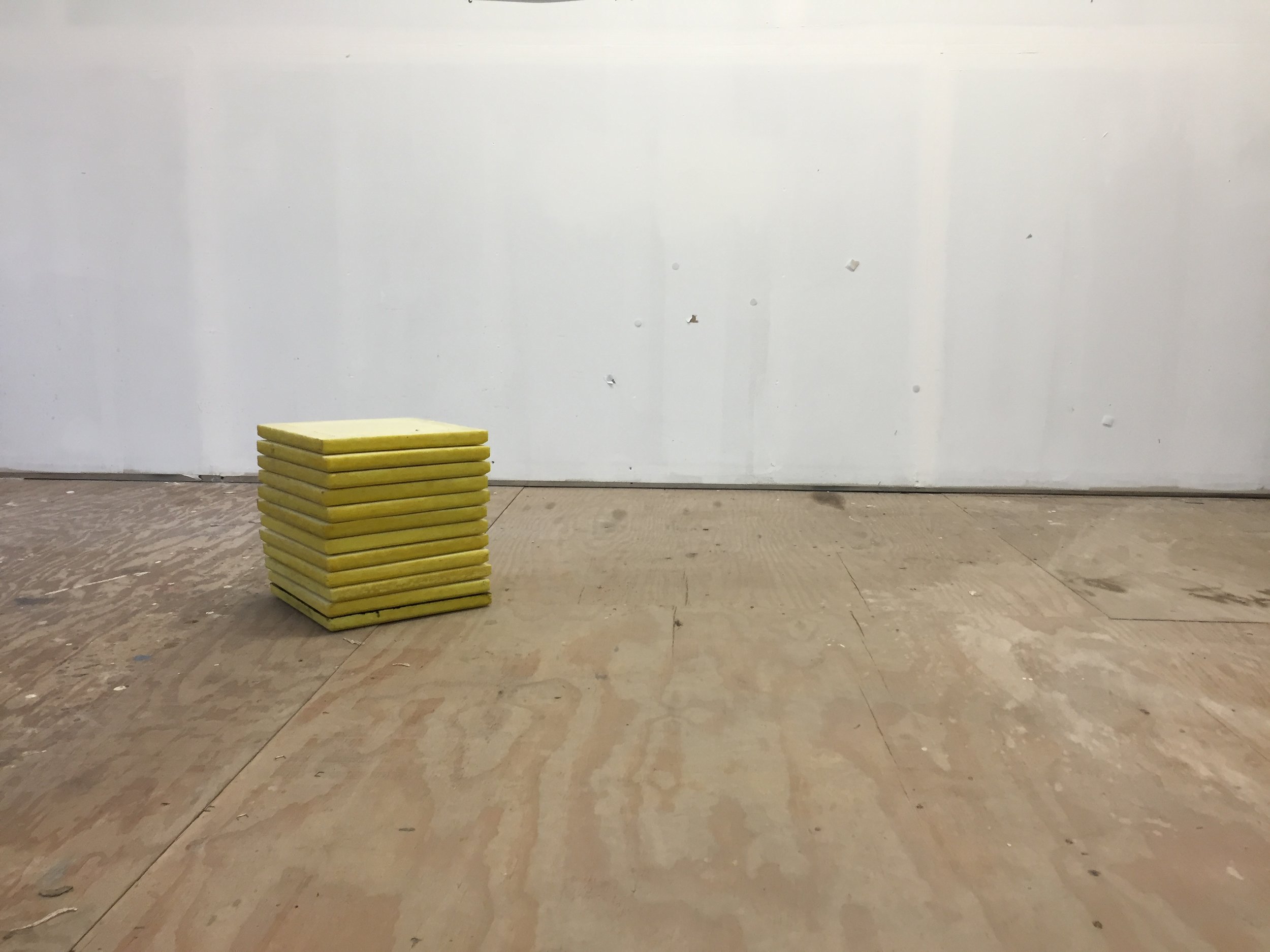this week shown from the studio.
Listening Space
I continue to navigate ways of seeing and interacting in spatial environments. What is present but not visible? The acknowledgement of the space sound inhabits and moves through allows the sculpture to render the invisible visible. The space the sound absorption panel occupies is the focal point of what is otherwise transparent.
These are ink prints created with a time and location stamp that equates to the moment they inhabit and energy converted within the panel from sound. Using the sound absorption panel as the stamp the prints make the invisible visible. Materializing the sound, energy and time.
[CLICK ON RIGHT SIDE OF IMAGE TO SCROLL THROUGH FULL SET OF IMAGES.]
Materials:
Fiberglass: Thermal, acoustic and anti-vibration insulation material
Shown with 12 sound absorption panels stacked without cover
Size: 30 x 30 x 2.5 cm/11.81 x 11.81 x 0.98 inch (L x W x H)
Readings:
“I can see nobody on the road,’ said Alice
‘I only wish I had such eyes,’ the King remarked in a fretful tone, ‘to be able to see Nobody! And at this distance too! Why, it’s as much as I can do to see real people, by this light!”
- Lewis Carroll
“an art based on the unity of time and, space, sound, the elements of time, the movement that develops in time and space, these are the basic forms of this new art that contains the four dimensions of existence.”
- Lucio Fontana, on Spatialism
“A place is nothing: not even space, unless at its heart – a figure stands.”
- Paul Dirac, Theoretical Physicist
Walking along a road after a rain, I see many puddles. Some are large, some small. Some spread out sideways, some lengthwise. Some show reflections of the sky, some of buildings. A casual walker may suddenly stop in front of a puddle. It does not seem especially different from the others, but for some reason he lingers in front of it. Did the puddle wink at him? Did something in the puddle display characteristics to which his sensory organs readily responded, leading to his self-awareness? Was there a well-timed interaction between as erogenous zone in the puddle and his sensory receptors? Whatever the reason, he suddenly “sees” the vividness of the world in the puddle. Or one might say there has been a sudden “encounter” between something here and something out there. Of course, it would not do to try to explain the content of this “encounter” or possess it by making it into an object. At a certain moment, the puddle and the person have an open relationship in which they communicate with each other. This sort of experience is what Gaston Bachelard calls the “visitation of a poetic moment,” which transcends all fixed concepts and objective theories.
(Yi, U-hwan, Alexander Munroe, Akira Tatehata, and Mika Yoshitake, Lee Ufan: marking infinity. NY, NY: Guggenheim Museum, 2011, 115.)
[HAVE SOUND ON FOR VIDEO]
State (In development)
16mm film is shown on back spool of film projector and front spool seen missing. The film projector is broken. It doesn’t move forward or backward, stuck in a singular position. The light is burnt out, but the sound works yet is unable to play or be heard. On the adjacent wall the touch activating conductive paint, circuit board and speaker are seen in the projection space. The audio has been loaded on an SD Card Reader within the circuit board. The viewer must participate by touching the conductive paint which activates the audio component, ending the silence.
Materials:
16mm film Irving Feiner vs New York court proceedings, 16mm Film Projector, Conductive paint, Circuit board, Speaker
Sounds: Donald Trump on protestors, Crystal bowl sound bath at healing frequency at 450%
*Additional reel to be shown on other side as well, which is not displayed in this video.
Readings:
"As soon as I hear a sound, it always suggests a mood to me."
- Brian Eno
Irving Feiner v. New York
https://en.wikipedia.org/wiki/Feiner_v._New_York
U.S. Supreme Court
Feiner v. New York, 340 U.S. 315 (1951)
Feiner v. New York
No. 93
Argued October 17, 1950
Decided January 15, 1951
340 U.S. 315
CERTIORARI TO THE COURT OF APPEALS OF NEW YORK
Syllabus
Petitioner made an inflammatory speech to a mixed crowd of 75 or 80 Negroes and white people on a city street. He made derogatory remarks about President Truman, the American Legion, and local political officials, endeavored to arouse the Negroes against the whites, and urged that Negroes rise up in arms and fight for equal rights. The crowd, which blocked the sidewalk and overflowed into the street, became restless; its feelings for and against the speaker were rising, and there was at least one threat of violence. After observing the situation for some time without interference, police officers, in order to prevent a fight, thrice requested petitioner to get off the box and stop speaking. After his third refusal, and after he had been speaking over 30 minutes, they arrested him, and he was convicted of violating § 722 of the Penal Code of New York, which, in effect, forbids incitement of a breach of the peace. The conviction was affirmed by two New York courts on review.
Held: The conviction is sustained against a claim that it violated petitioner's right of free speech under the First and Fourteenth Amendments. Pp. 340 U. S. 316-321.
(a) Petitioner was neither arrested nor convicted for the making or the content of his speech, but for the reaction which it actually engendered. Pp. 340 U. S. 319-320.
(b) The police cannot be used as an instrument for the suppression of unpopular views; but, when a speaker passes the bounds of argument or persuasion and undertakes incitement to riot, the police are not powerless to prevent a breach of the peace. P. 340 U. S. 321.
MORE AT: https://supreme.justia.com/cases/federal/us/340/315/case.html#321














